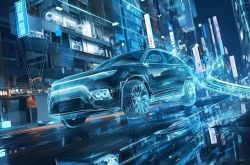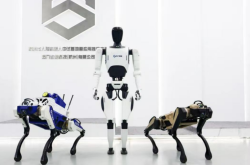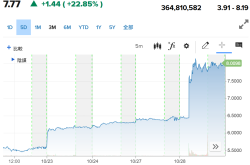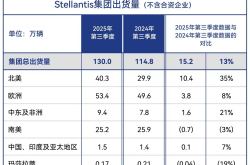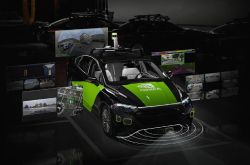Breaking News! 500 Million Yuan in Financing Secured, with National Backing! Specialized Robotics Takes Center Stage
![]() 10/29 2025
10/29 2025
![]() 535
535
Let me share something with you. Recently, a promising robotics unicorn has emerged on the scene in Hangzhou: It has just announced a staggering 500 million yuan in financing today—introducing 58 Robotics.
This company stands out from the crowd, exuding a strong national team spirit.
Firstly, it operates as a state-owned enterprise under the umbrella of China National Ordnance Equipment Group Corporation.
Secondly, the majority of its investors in this funding round also hail from the national team, including Guoxin Fund, Zhejiang Industrial Investment, China Mixed Ownership Reform Fund for State-Owned Enterprises, and Zhejiang Provincial Science and Technology Innovation Mother Fund (Phase III).
Moreover, its product application scenarios are quintessentially national team-oriented, such as aerospace and emergency safety, falling under the categories of major security and significant industries. Its product lineup includes humanoid robots and quadruped robots, excelling in governmental settings.
Let me provide you with two examples, and you'll grasp the concept. It has developed tailored solutions for public security practical scenarios, launching a police series of quadruped robot dogs that can act as the 'avatars' and 'substitutes' for frontline police officers in patrol and prevention, anti-riot disposal, and more.
So, why is this company worth discussing? Pencil News has covered numerous robot unicorns, but most are market-driven teams. Has anyone truly delved into: What are the application scenarios for robots in government business directions?
Of course, 58 Robotics' true domain should be: Robots - Major Security/Major Industrial Robots. However, from its application scenarios, one of the key purchasers is the government, especially for major security robots.
Taking advantage of 58 Robotics' current funding round, let's explore what other super opportunities exist in this sector.
- 01 -
58 Robotics was established in February 2022. Why was it founded? Primarily because traditional robots were deemed inadequate, being bulky in hardware, slow in perception, rigid in decision-making, having weak grasping abilities, being clumsy and inflexible in movement, and not very intelligent—mostly 'fixed program executors.'
Most of the founding team of 58 Robotics come from research institutions, such as the Automation Research Institute of China National Ordnance Equipment Group Corporation and the Hangzhou Zhiyuan Research Institute, boasting strong accumulations in military technology.
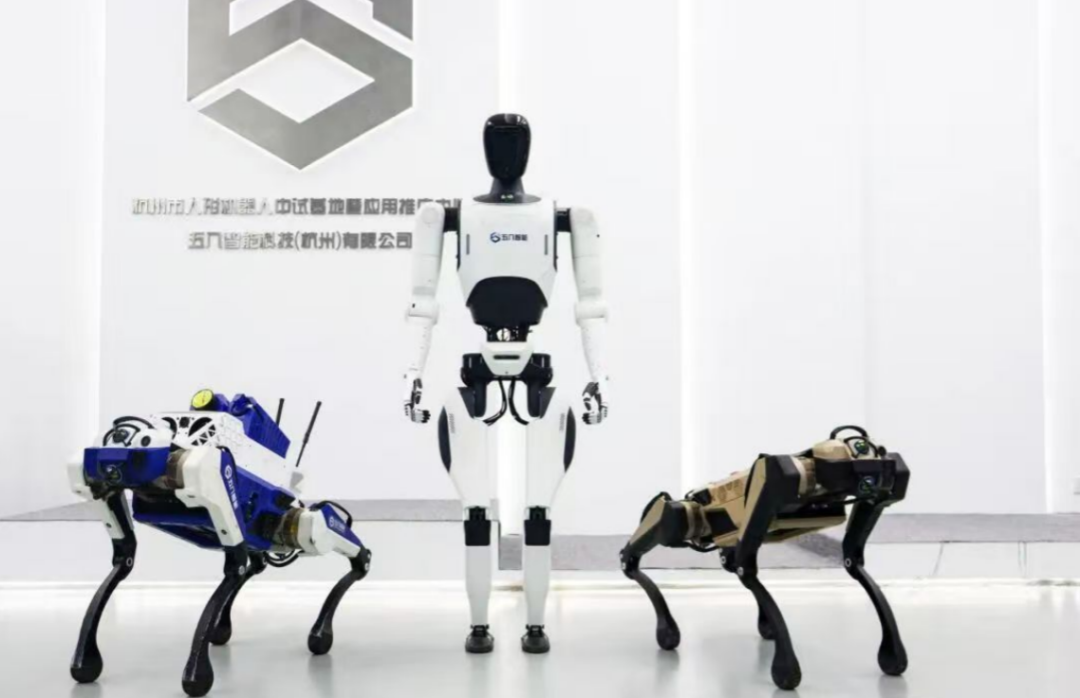
Display of Core Products by 58 Robotics
From publicly available information, 58 Robotics boasts several core products:
1. Patrol and Prevention Robot Dog: Equipped with fully autonomous patrol capabilities, it can conduct 24-hour uninterrupted autonomous patrols within community, street, and shopping mall jurisdictions, transmitting real-time footage back to the command center.
2. Anti-riot Disposal Robot Dog: Equipped with integrated modules such as payload throwing devices and strong sound and light, it can perform lighting and tactical suppression functions during nighttime missions, replacing police officers in executing some dangerous anti-riot tasks.
3. Q10 Small Wheeled-Foot Police Robot Dog: A new product launched by 58 Robotics, with specific functions not yet fully disclosed. However, as a police robot dog, it is expected to play a role in specific police scenarios, such as narrow space patrols and detailed investigations.
4. Dasheng Humanoid Robot: A new generation of general-purpose full-size humanoid robot developed for major security, major industrial, and commercial service scenarios. Its application scenarios include traffic command on urban main roads or crowd management at large event venues and scenic spots.
After seeing these four products, can you sense its 'governmental' vibe? Indeed, it's quite evident. Only government-related departments, state-owned enterprises, and some public service institutions can utilize these products.
For example, the Xixi Wetland Police Station under the Xihu District Public Security Bureau in Hangzhou has purchased patrol and prevention robot dogs. Additionally, according to a contract from the Anhui Provincial Government Procurement Online Supermarket, a certain municipal company in Hefei has purchased patrol and prevention robot dogs, with a winning bid amount of 266,000 yuan.
- 02 -
Although 58 Robotics spans two sectors: major security and major industries, from the perspective of its product attributes, the security aspect is currently more prominent. Therefore, this article will first focus on analyzing the major security robot sector.
Firstly, from the perspective of product forms, security robots mainly include two types: quadruped robot dogs and humanoid robots.
Robot dogs are more mature. After all, their early products were primarily used in military and scientific research, conducting reconnaissance and detection tasks in complex environments.
Then, someone might ask, can robot dogs safeguard our safety? Yes, they can.
They can be equipped with sensors, such as panoramic cameras, dual-light pan-tilt-zoom cameras, gas sensors, etc., which can be applied in firefighting. Their 360° panoramic cameras can transmit high-definition footage of the fire scene, and their gas sensors can detect toxic gases.
Moreover, they can reduce casualties. For example, in scenarios such as mine clearance, bomb disposal, and dangerous gas detection, they can assist humans in executing dangerous tasks. So, aren't they excellent safety partners for humans?
Next, let's talk about humanoid robots (for security). What does security have to do with them? The lively humanoid robots this year are either dancing, running, playing football, or lying in laboratories for research. Can they be competent in security work?
The answer is: Yes, they can.
Their security scenarios are somewhat similar to those of quadruped robot dogs. Then, the question arises: Since there are already quadruped robot dogs, why are humanoid robots still needed? What can humanoid robots do in security scenarios that robot dogs cannot?
'Dogs' are, after all, 'dogs,' and 'humans' are, after all, 'humans.' Humans have hands and can stand upright. These 'biological characteristics' determine that humanoid robots can do some special things.

Comparison of Application Scenarios for Two Types of Robots
For example, in high-risk equipment disposal scenarios requiring precise hand operations.
Quadruped robot dogs have limitations: They can only carry equipment for detection or transportation, lacking flexible 'hands' to perform precise operations such as rotating valves, pressing emergency buttons, or disassembling faulty components.
Another example is narrow/structured scenarios that need to adapt to human workspaces. The world—including vehicle cockpits, command centers, factory control panels, and stair dimensions—is designed and built according to human body sizes and operational habits.
Although quadruped robot dogs can traverse complex terrains, their body morphology, with four limbs on the ground, prevents them from standing upright to enter narrow passages (such as pipeline inspection ports with a diameter of 50 cm) or climbing vertical ladders for operations. They also have difficulty operating tools on human-used work surfaces such as desks and equipment control panels.
- 03 -
Then, someone might ask: Are these robots truly competent for their positions, or are they still novices with many immature technologies? Well, the answer is affirmative; they are indeed still novices. However, as new innovations, they are imperfect when they first emerge, and we need to be more patient.
What are the areas where security robots are still novices?
Firstly, algorithms. Without sufficiently intelligent algorithms, it's equivalent to robots having a poor brain, lacking real-time decision-making capabilities, and struggling to cope with various unknown emergency situations.
Secondly, hardware. The lifespan of some key hardware components is limited. For example, the lifespan of joint actuators may be between 2,000 and 5,000 hours, affecting the long-term stable operation of robots. Especially in extreme environments like the deep sea, power systems (such as propellers) may experience 'power attenuation' or 'short-circuit shutdown' due to seawater impurity blockages and salt spray corrosion.
Thirdly, the standard system. The construction of industry standards for security robots lags behind. Unlike today's mobile phones, which already have mature operating systems and application standards, the national and industry levels have recognized this and are actively promoting the development of basic protocols and interface standards to reduce integration complexity.
Finally, legal and ethical issues. Of course, this is a long-term issue. In today's society governed by the rule of law, robots will also be a new species in the future and will need to be managed. However, this aspect is currently not mature enough.
- 04 -
In the security robot sector, there are both competitive and emerging markets.
The competitive market areas mainly include some mature security scenarios, such as public security patrols and fire rescue, where competition is fierce. Their common characteristics are homogeneous competition, with most technologies being mature and functions being singular (patrolling, monitoring, etc.).
For example, most robots currently can only undertake patrolling and monitoring tasks. When a real danger occurs, they often only serve as alarms and cannot directly solve problems, falling far short of the public's expectation of independent 'robot police.'
According to Beijing Boyan Zhishang Data, the market size of public security patrol robots in China was approximately 7.83 billion yuan in 2024, accounting for 41.7% of the overall security robot market, with leading companies such as Hikvision and Dahua Technology.
Although 58 Robotics has also launched patrol and prevention robot dogs for police scenarios, which can conduct 24-hour uninterrupted autonomous patrols within community, street, and shopping mall jurisdictions, the market competition it faces remains fierce.
Then, what about the emerging market sectors? Of course, they include complex security scenarios related to AI large models and overall machine design. Generally, these companies are strongly driven by capital and require long-term investment from national team industrial funds.
Specifically, product types include underwater security robots, industrial special operation robots, and extreme environment operation robots.
1. Underwater security robots.
The reconfiguration of the international trade landscape, coupled with stricter global environmental regulations, has driven a surge in demand in the marine economy sector.
Underwater robots can replace human labor to complete high-risk tasks such as ship hull derusting and submarine pipeline inspection, forming technological barriers in fields like smart ports and green shipping. However, the current number of main participants in the market is relatively small.
2. Industrial special operation and maintenance robots.
In industrial scenarios such as steel mines, coal coking and chemical engineering, and power energy, the operation and maintenance of complex spaces are 'high-risk zones.' Manual inspections not only have low frequency and are prone to missed detections but also pose safety risks.
This field is still in its early development stage, with huge market potential.
3. High-temperature and other extreme environment operation robots.
Currently, the market development level of robots capable of operating in extreme environments such as high temperatures and strong magnetic fields is relatively low, with few enterprises in China daring to design such robots.
The hundreds of millions of yuan in financing for 58 Robotics is like a 'signal light' for the major security robot sector. The signal for accelerated development in this sector has just begun.



